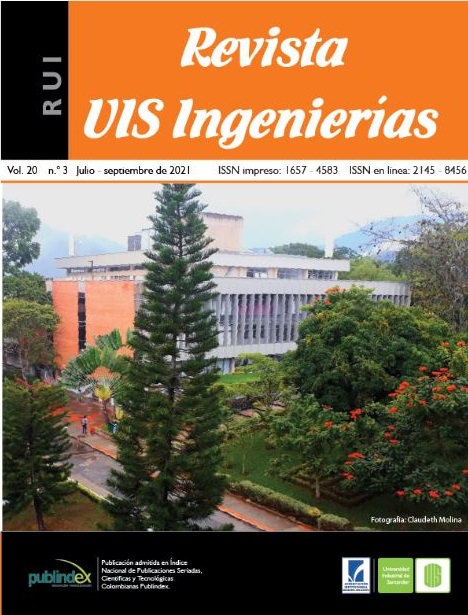Mejora eficiente para la estimación de la energía libre superficial del ligante asfáltico mediante herramientas de Machine Learning
Publicado 2021-06-07
Palabras clave
- cemento asfáltico,
- energía libre de superficies,
- mezclas asfálticas,
- aprendizaje automático,
- plan estratégico de investigación de carreteras
Cómo citar
Resumen
La energía libre de superficie de un material se define como la energía necesaria para crear una nueva unidad de superficie en condiciones de vacío. Esta propiedad está directamente relacionada con la resistencia a la fractura y recuperación de un material y con la capacidad de crear una fuerte adhesión con otros materiales. Este valor puede ser utilizado como parámetro complementario para la selección y combinación óptima de materiales para mezclas asfálticas, así como en el modelado micromecánico de procesos de fractura y recuperación de dichas mezclas. Este documento describe los resultados de la implementación del uso del aprendizaje automático y las técnicas de predicción de bosque aleatorio para la estimación de la energía libre superficial basada en datos de estudios anteriores. Las muestras experimentales fueron veintitrés ligantes de asfalto usados en un Programa de Investigación Estratégica de Carreteras (SHRP). Podemos destacar una disminución de 54% y 82% en el error medio absoluto (MAE) y el error cuadrático medio (MSE), respectivamente. Si bien el modelo encaja mejor con una mejora del 12%, según el coeficiente de determinación ajustado, la precisión y la puntuación del modelo también aumentan notablemente en un 2% y 55% respectivamente.
Descargas
Referencias
[2] K. L. Mittal, Contact Angle, Wettability and Adhesion, Volume 3. Boca Ratón, FL, USA: CRC Press, 2003.
[3] P. G. De Gennes, “Wetting: statics and dynamics,” Reviews of modern physics, vol. 57, no. 3, pp. 827, 1985. doi: 10.1103/RevModPhys.57.827
[4] O. Voinov, “Dynamics of a viscous liquid wetting a solid via van der waals forces,” Journal of Applied Mechanics and Technical Physics, vol. 35, no. 6, pp. 875-890, 1994. doi: 10.1007/BF02369581
[5] E. Ramé, “The interpretation of dynamic contact angles measured by the wilhelmy plate method,” Journal of colloid and interface science, vol. 185, no. 1, pp. 245-251, 1997. doi: 10.1006/jcis.1996.4589
[6] L. M. Lander, L. M. Siewierski, W. J. Brittain, E. A. Vogler, “A systematic comparison of contact angle methods,” Langmuir, vol. 9, no. 8, pp. 2237-2239, 1993.
[7] H. Wu, A. Shen, Z. He, T. Cui, “Study on adhesion between asphalt and steel slag based on surface free energy,” in 20th COTA International Conference of Transportation Professionals, 2020, pp. 1851-1864.
[8] Y. Yuan, T. R. Lee, “Contact angle and wetting properties,” in Surface science techniques, vol. 51. Springer, 2013, pp. 3-34. doi: 10.1007/978-3-642-34243-1_1
[9] C. Maze, G. Burnet, “A non-linear regression method for calculating surface tension and contact angle from the shape of a sessile drop,” Surface Science, vol. 13, no. 2, pp. 451-470, 1969. doi: 10.1016/0039-6028(69)90204-0
[10] J. Bachmann, R. Horton, R. Van Der Ploeg, S. Woche, “Modified sessile drop method for assessing initial soil–water contact angle of sandy,” Soil Science Society of America Journal, vol. 64, no. 2, pp. 564-567, 2000. doi: 10.2136/sssaj2000.642564x
[11] L. Susana, F. Campaci, A. C. Santomaso, “Wettability of mineral and metallic powders: applicability and limitations of sessile drop method and washburn’s technique,” Powder technology, vol. 226, pp. 68-77, 2012. doi: 10.1016/j.powtec.2012.04.016
[12] A. Bhasin, D. N. Little, “Characterization of aggregate surface energy using the universal sorption device,” Journal of Materials in Civil Engineering, vol. 19, no. 8, pp. 634-641, 2007. doi: 10.1061/(ASCE)0899-1561(2007)19:8(634)
[13] B. M. Kiggundu, F. L. Roberts, “Stripping in hma mixtures: state-of-the-art and critical review of test methods,” National Center for Asphalt Technology, Tech. Rep. NCAT Report 88- 02, 1988.
[14] J. Wei, Y. Zhang, “The application of grey system theory to correlate chemical composition and surface free energy of asphalt binders,” Petroleum Science and Technology, vol. 28, no. 17, pp. 1807-1817, 2010. doi: 10.1080/10916460903226098
[15] J. Wei, F. Dong, Y. Li, Y. Zhang, “Relationship analysis between surface free energy and chemical composition of asphalt binder,” Construction and Building Materials, vol. 71, pp. 116-123, 2014. doi: 10.1016/j.conbuildmat.2014.08.024
[16] I. Jolliffe, “Principal component analysis,” International Encyclopedia of Statistical Science. Heidelberg, Berlín: Springer, 2011, pp. 1094-1096. Doi: 10.1007 / 978-3-642-04898-2_455
[17] R. C. Team et al., “R: A language and environment for statistical computing,” 2013.
[18] A. G. Bunn, “A dendrochronology program library in r (dplr),” Dendrochronologia, vol. 26, no. 2, pp. 115-124, 2008. doi: 10.1016/j.dendro.2008.01.002
[19] A. G. Bunn, “Statistical and visual crossdating in r using the dplr library,” Dendrochronologia, vol. 28, no. 4, pp. 251-258, 2010. doi: 10.1016/j.dendro.2009.12.001
[20] A. Tsanas, M. A. Little, P. E. McSharry, L. O. Ramig, “Accurate telemonitoring of parkinson’s disease progression by noninvasive speech tests,” Nature Precedings, pp. 1, 2010. doi: 10.1038/npre.2009.3920.1
[21] H. Trevor, T. Robert, and F. Jerome, The elements of statistical learning: data mining, inference, and prediction, 2da. Ed. Stanford, CA, USA: Springer, 2009.
[22] L. Breiman, “Random forests,” Machine learning, vol. 45, no. 1, pp. 5-32, 2001. doi: 10.1023/A:1010933404324


